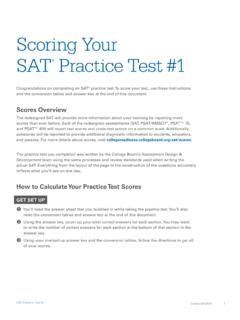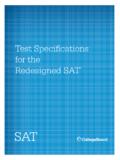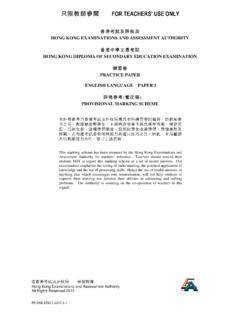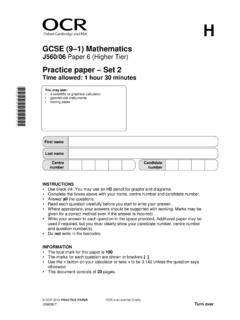Transcription of SAT Practice Test #3 | SAT Suite of Assessments – The ...
1 Practice Test 2016 The College Board. College Board, SAT, and the acorn logo are registered trademarks of the College time to take the Practice s one of the best ways to get ready for the you ve taken the Practice test, score it right away at begins on the next Test65 MINUTES, 52 QUESTIONSTurn to Section 1 of your answer sheet to answer the questions in this passage or pair of passages below is followed by a number of questions. After readingeach passage or pair, choose the best answer to each question based on what is stated orimplied in the passage or passages and in any accompanying graphics (such as a table orgraph).Questions 1-10 are based on the passage is adapted from Saki, TheSchartz-Metterklume Method. Originally published in Carlotta stepped out on to the platform ofthe small wayside station and took a turn or two upand down its uninteresting length, to kill time till thetrain should be pleased to proceed on its way.
2 Then,in the roadway beyond, she saw a horse strugglingwith a more than ample load, and a carter of the sortthat seems to bear a sullen hatred against the animalthat helps him to earn a living. Lady Carlottapromptly betook her to the roadway, and put rather adifferent complexion on the struggle. Certain of heracquaintances were wont to give her plentifuladmonition as to the undesirability of interfering onbehalf of a distressed animal, such interference being none of her business. Only once had she put thedoctrine of non-interference into Practice , when oneof its most eloquent exponents had been besieged fornearly three hours in a small and extremelyuncomfortable may-tree by an angry boar-pig, whileLady Carlotta, on the other side of the fence, hadproceeded with the water-colour sketch she wasengaged on, and refused to interfere between theboar and his prisoner.
3 It is to be feared that she lostthe friendship of the ultimately rescued lady. On thisoccasion she merely lost the train, which gave way tothe first sign of impatience it had shown throughoutthe journey, and steamed off without her. She borethe desertion with philosophical indifference; herfriends and relations were thoroughly well used tothe fact of her luggage arriving without wired a vague non-committal message to herdestination to say that she was coming on byanother train. Before she had time to think what hernext move might be she was confronted by animposingly attired lady, who seemed to be taking aprolonged mental inventory of her clothes and looks. You must be Miss Hope, the governess I ve cometo meet, said the apparition, in a tone that admittedof very little argument. Very well, if I must I must, said Lady Carlotta toherself with dangerous meekness.
4 I am Mrs. Quabarl, continued the lady; andwhere, pray, is your luggage? It s gone astray, said the alleged governess,falling in with the excellent rule of life that the absentare always to blame; the luggage had, in point of fact,behaved with perfect correctitude. I ve justtelegraphed about it, she added, with a nearerapproach to truth. How provoking, said Mrs. Quabarl; theserailway companies are so careless. However, mymaid can lend you things for the night, and she ledthe way to her copying or reuse of any part of this page is the drive to the Quabarl mansionLady Carlotta was impressively introduced to thenature of the charge that had been thrust upon her;she learned that Claude and Wilfrid were delicate,sensitive young people, that Irene had the artistictemperament highly developed, and that Viola was552something or other else of a mould equallycommonplace among children of that class and typein the twentieth century.
5 I wish them not only to be TAUGHT, said , but INTERESTED in what they learn. Intheir history lessons, for instance, you must try tomake them feel that they are being introduced to thelife-stories of men and women who really lived, notmerely committing a mass of names and dates tomemory. French, of course, I shall expect you to talkat meal-times several days in the week. I shall talk French four days of the week andRussian in the remaining three. Russian? My dear Miss Hope, no one in thehouse speaks or understands Russian. That will not embarrass me in the least, saidLady Carlotta Quabarl, to use a colloquial expression, wasknocked off her perch. She was one of thoseimperfectly self-assured individuals who aremagnificent and autocratic as long as they are notseriously opposed. The least show of unexpectedresistance goes a long way towards rendering themcowed and apologetic.
6 When the new governessfailed to express wondering admiration of the largenewly-purchased and expensive car, and lightlyalluded to the superior advantages of one or twomakes which had just been put on the market, thediscomfiture of her patroness became almost feelings were those which might have animated ageneral of ancient warfaring days, on beholding hisheaviest battle-elephant ignominiously driven off thefield by slingers and javelin choice best summarizes the passage?A)A woman weighs the positive and negativeaspects of accepting a new ) A woman does not correct a stranger whomistakes her for someone ) A woman impersonates someone else to seekrevenge on an ) A woman takes an immediate dislike to her line 2, turn most nearly meansA)slight ) change in ) short ) course passage most clearly implies that other peopleregardedLady Carlotta asA) ) ) ) choice provides the best evidence for theanswerto the previous question?
7 A) Lines 10-14 ( )B) Lines 22-23 ( It )C) Lines 23-26 ( On )D) Lines 30-32 ( ) copying or reuse of any part of this page is description of how Lady Carlotta put thedoctrineof non-interference into Practice (lines 14-15) mainly serves toA) foreshadow her capacity for ) illustrate the subtle cruelty in her ) provide a humorous insight into her ) explain a surprising change in her line 55, charge most nearly meansA) ) ) ) narrator indicates that Claude, Wilfrid, Irene,andViola areA) similar to many of their ) unusually creative and ) hostile to the idea of a ) more educated than others of their narrator implies that Mrs. Quabarl favors a formofeducation that emphasizesA) traditional ) active ) artistic ) factual presented in the passage, Mrs. Quabarl is bestdescribedasA) superficially kind but actually ) outwardly imposing but easily ) socially successful but irrationally ) naturally generous but frequently choice provides the best evidence for theanswerto the previous question?
8 A) Lines 49-50 ( )B) Lines 62-68 ( I )C) Lines 70-73 ( I )D) Lines 77-82 ( She ) copying or reuse of any part of this page is 11-20 are based on the followingpassage and supplementary passage is adapted from Taras Grescoe,Straphanger:Saving Our Cities and Ourselves from the Automobile. 2012by Taras there are 600 million cars on the planet,and counting, there are also seven billion people,which means that for the vast majority of us gettingaround involves taking buses, ferryboats, commutertrains, streetcars, and subways. In other words,traveling to work, school, or the market means beinga straphanger: somebody who, by choice or necessity,relies on public transport, rather than a privatelyowned the population of New York, Toronto, andLondon do not own cars. Public transport is howmost of the people of Asia and Africa, the world smost populous continents, travel.
9 Every day, subwaysystems carry 155 million passengers, thirty-fourtimes the number carried by all the world s airplanes,and the global public transport market is now valuedat $428 billion annually. A century and a half afterthe invention of the internal combustion engine,private car ownership is still an yet public transportation, in many minds, isthe opposite of glamour a squalid last resort forthose with one too many impaired driving charges,too poor to afford insurance, or too decrepit to getbehind the wheel of a car. In much of NorthAmerica, they are right: taking transit is a depressingexperience. Anybody who has waited far too long ona street corner for the privilege of boarding alurching, overcrowded bus, or wrestled luggage ontosubways and shuttles to get to a big city airport,knows that transit on this continent tends to beunderfunded, ill-maintained, and ill-planned.
10 Giventhe opportunity, who wouldn t drive? Hopping in acar almost always gets you to your destination doesn t have to be like this. Done right, publictransport can be faster, more comfortable, andcheaper than the private automobile. In Shanghai,German-made magnetic levitation trains skim overelevated tracks at 266 miles an hour, whisking peopleto the airport at a third of the speed of sound. Inprovincial French towns, electric-powered streetcarsrun silently on rubber tires, sliding through narrowstreets along a single guide rail set into Spain to Sweden, Wi-Fi equipped high-speedtrains seamlessly connect with highly ramified metronetworks, allowing commuters to work on laptops asthey prepare for same-day meetings in once distantcapital cities. In Latin America, China, and India,working people board fast-loading buses that movelike subway trains along dedicated busways, leavingthe sedans and SUVs of the rich mired indawn-to-dusk traffic jams.



















